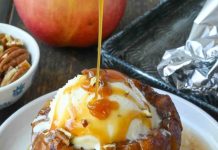Imagine the joy of biting into a slice of freshly baked ciabatta bread—crunchy on the outside, soft and airy on the inside. This Italian classic is perfect for creating delicious sandwiches, dipping into olive oil, or enjoying with a variety of meals. Best of all, you don’t need to be a professional baker to make this delightful bread at home. With just a few basic ingredients and a straightforward process, you can whip up a loaf of ciabatta that’s as impressive as it is affordable.
Let’s explore how you can make this easy and budget-friendly bread that will surely become a staple in your kitchen!
Preparation Overview:
- Preparation Time: 15 minutes
- Rising Time: 1-2 hours
- Baking Time: 20 minutes
- Total Time: Between 1 hour and 35 minutes and 2 hours and 35 minutes
Ingredients:
- 500 grams bread flour (approximately 3 1/3 cups)
- 5 grams salt (1 teaspoon)
- 5 grams active dry yeast (2 teaspoons)
- 375-400 ml warm water (start with 375 ml, adjust as needed)
- 30 grams olive oil (2 tablespoons)
Instructions:
1. Activate the Yeast:
In a small bowl, dissolve the active dry yeast in 100 ml of warm water from the total 375-400 ml. Allow it to sit for about 5 minutes until it becomes frothy. This step is essential for ensuring the yeast is active and will help the dough rise properly.
2. Mix the Dough:
In a large bowl, combine the bread flour and salt. Add the yeast mixture, the remaining water, and olive oil to the flour. Stir until the dough begins to come together. The dough should be somewhat sticky; if it feels too dry, gradually add more water until it reaches the right consistency.
3. First Rise:
Cover the bowl with a clean cloth or plastic wrap and place it in a warm, draft-free area. Allow the dough to rise for 1-2 hours, or until it has doubled in size. This rising period is crucial for developing the bread’s light and airy texture.
4. Shape the Dough:
Preheat your oven to 220°C (430°F). Generously flour a clean surface and gently transfer the dough onto it. Be careful not to deflate it too much. Shape the dough into a rough rectangle by folding and stretching it a few times. Transfer the dough to a baking sheet lined with parchment paper or a floured cloth. Cover and let it rise for an additional 30 minutes.
5. Bake the Ciabatta:
Place the baking sheet in the preheated oven and bake for about 20 minutes. The ciabatta should have a golden-brown crust with a crisp exterior. For an extra-crispy crust, place a small pan of water in the oven to create steam during baking.
6. Cool and Enjoy:
Remove the bread from the oven and let it cool on a wire rack before slicing. This step allows the bread to set properly and makes it easier to cut.
Serving Suggestions:
- Dipping Delight: Serve with olive oil and balsamic vinegar for a tasty dip.
- Sandwich Base: Use for making sandwiches or paninis.
- Accompaniment: Enjoy with soups or salads for a satisfying meal.
Baking Tips:
- Yeast Activation: Ensure the water is warm, not hot, to properly activate the yeast.
- Handling the Dough: Be gentle with the dough to maintain its airy texture.
- Storage: Keep leftover bread in a sealed container at room temperature for up to 2 days. For longer storage, wrap tightly in plastic wrap and freeze for up to a month. Reheat in the oven before serving.
Nutritional Benefits:
- Olive Oil: Contains healthy fats beneficial for heart health.
- Bread Flour: Higher protein content aids in developing a better gluten structure for a lighter texture.
Frequently Asked Questions:
- Can I Use All-Purpose Flour? Yes, you can use all-purpose flour, but bread flour is recommended for a better texture due to its higher protein content.
- What If My Dough Is Too Sticky? Ciabatta dough tends to be sticky. If it’s overly wet, sprinkle a bit more flour, but do so cautiously to avoid altering the dough’s texture.
- Can I Refrigerate the Dough Overnight? Yes, you can refrigerate the dough overnight. Let it come to room temperature before shaping and baking.
- Do I Need a Special Pan? No, a regular baking tray lined with parchment paper will work perfectly.
- Can I Add Flavors? Absolutely! Feel free to mix in herbs, garlic, or olives for added flavor.
- How Do I Know When the Bread Is Done? The bread should be golden brown and sound hollow when tapped on the bottom. An internal temperature of about 90°C (195°F) is ideal.
- Can I Double the Recipe? Yes, you can double the ingredients to make two loaves. Just divide the dough evenly before the second rise.
Conclusion:
Making ciabatta bread at home is a rewarding and straightforward process that brings the taste of Italy right into your kitchen. With its crispy crust and airy interior, this ciabatta recipe is perfect for a variety of uses, from sandwiches to soups. Its simplicity and affordability make it an excellent choice for bakers of all levels. So, gather your ingredients, follow these easy steps, and enjoy the delightful results of your homemade ciabatta bread. Happy baking! 💖
Source of the picture : Barbara O’Neill










